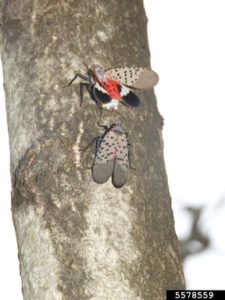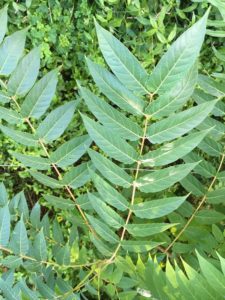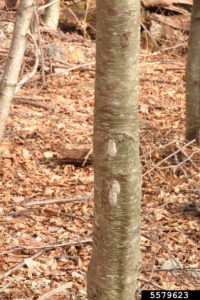Spotted Lanternfly
go.ncsu.edu/readext?611027
en Español / em Português
El inglés es el idioma de control de esta página. En la medida en que haya algún conflicto entre la traducción al inglés y la traducción, el inglés prevalece.
Al hacer clic en el enlace de traducción se activa un servicio de traducción gratuito para convertir la página al español. Al igual que con cualquier traducción por Internet, la conversión no es sensible al contexto y puede que no traduzca el texto en su significado original. NC State Extension no garantiza la exactitud del texto traducido. Por favor, tenga en cuenta que algunas aplicaciones y/o servicios pueden no funcionar como se espera cuando se traducen.
Português
Inglês é o idioma de controle desta página. Na medida que haja algum conflito entre o texto original em Inglês e a tradução, o Inglês prevalece.
Ao clicar no link de tradução, um serviço gratuito de tradução será ativado para converter a página para o Português. Como em qualquer tradução pela internet, a conversão não é sensivel ao contexto e pode não ocorrer a tradução para o significado orginal. O serviço de Extensão da Carolina do Norte (NC State Extension) não garante a exatidão do texto traduzido. Por favor, observe que algumas funções ou serviços podem não funcionar como esperado após a tradução.
English
English is the controlling language of this page. To the extent there is any conflict between the English text and the translation, English controls.
Clicking on the translation link activates a free translation service to convert the page to Spanish. As with any Internet translation, the conversion is not context-sensitive and may not translate the text to its original meaning. NC State Extension does not guarantee the accuracy of the translated text. Please note that some applications and/or services may not function as expected when translated.
Collapse ▲The spotted lanternfly (Lycorma delicatula (White)) is a new invasive insect that was first identified in Berks County in eastern Pennsylvania in 2014. Since then, its presence has been confirmed in New Jersey, Delaware, and Virginia. The spotted lanternfly is native to China and was introduced in Korea in 2004, and has been a very destructive pest since. It has not yet been observed in North Carolina, but like many non-native invasive species, is likely to reproduce and spread freely as it currently has no known or active predators in its’ eastern United States habitat.
The spotted lanternfly is a planthopper and damages plants through feeding. It uses its piercing, sucking mouthpart to extract sugars and nutrients from plants. It then excretes a sugary substance called honeydew, and a black mold called ‘sooty’ mold grows on the honeydew, creating an unattractive black film on plant leaves. Spotted lanternflies have been observed congregating in large masses on different plants. The feeding lead to quick plant decline with heavy infestation. The lanternfly has hundreds of different plant hosts and holds the potential to cause major damage to trees and woody plants in the landscape such as pine, maples, and others. It also poses a threat to agricultural industries, and given its history, is of particular concern to the grape, tree fruit, hops, and nursery crop industries.

When wings are closed, the grey, black-spotted forewings are visible, and when wings are open the red coloring of the forewings is visible.
Spotted lanternfly can be identified by its wing coloration and patterns, both as nymphs and adults. Adults have two sets of wings: the forewings, closer to the head, are grey with black spots. The hindwings are red and black with a white band. The body is yellow with black stripes. It undergoes 4 nymph stages, or instars, before becoming adults. The eggs hatch between April and June, grow through the nymph stages and become adults between July and December. The first three nymphs are black with white or light yellow spots, and the fourth is red with black stripes and white spots. Adults lay their eggs September through December, and eggs may be observed through the winter on woody species. Egg masses look like tubes of mud stuck against a tree’s bark.
It appears to prefer laying its eggs on another invasive species, Tree-of-Heaven (Alianthus altissima). Studies are underway to determine whether the lanternfly requires Tree-of-Heaven to complete its life cycle. Tree of heaven is a non-native small tree species whose leaves resemble that of our native Staghorn Sumac (Rhys typhina). It is native to China and was first introduced in Pennsylvania in 1784 and was widely planted in the mid-Atlantic into the 20th century. It grows and spreads quickly and is now found in 42 states. It can be distinguished from Staghorn sumac by its leaf edges and by the flowers. The leaves are pinnately compound- each group of “leaflets” is actually one leaf. One leaf can grow upwards of 4’ long with 30-40 leaflets arranged opposite each other. Leaflets has smooth leaf margins, or edges, with a distinctive “tooth” at the base of each leaflet. Staghorn sumac produces a “drupe” of reddish flowers in mid-summer expanding upward from the leaves, and persisting through winter. Leaves on sumac are only up to 18” long and leaflets have toothed or serrated edges. Tree-of-Heaven has male and female trees. Female trees produce small white flowers and winged seedpods called samaras in late summer. Seeds can remain on the tree throughout winter. Tree-of-Heaven can reach 80-100’ in height but is relatively short-lived. The foliage is noted to have an unpleasing scent, resembling burnt peanut butter when crushed. Tree of Heaven can reproduce both by seed and by root suckers, which can sprout as far as 50’ away from the base of the parent tree.

Tree-of-Heaven is an invasive, fast growing tree whose leaflets have smooth edges, or margins, and have a distinctive tooth at the base of each leaflet.
It is only through vigilance and preventive measures that we can slow the spread of this destructive pest. Certain counties in Pennsylvania where spotted lanternfly has been observed have been placed under quarantine. Businesses operating in those counties must comply with regulations governing transport of goods and vehicles. Because many host plant species are vital to our landscapes and regional agricultural economy, it is especially important that we prevent the arrival of spotted lanternfly and make every attempt to eradicate it, should it arrive. As it is not here yet, citizens are asked to maintain vigilance, inspecting known host plants throughout the year and examining and washing cars when driving through infested regions of the country. If you have an orchard or vineyard, it is recommended that you remove any Tree-of-Heaven on site. More resources on identifying or preventing the introduction of the spotted lanternfly.
If you suspect you have seen the spotted lanternfly here in North Carolina, it is important that you contact the designated plant inspector with the North Carolina Department of Agriculture and Consumer Services. Chad Taylor is the plant inspector for Caldwell, Watauga, Alleghany, Ashe, and Alexander Counties. More information on what to do if you see spotted lanternfly in North Carolina.
If you have any further questions about spotted lanternfly or other pests in the garden, landscape, or crop field, contact the N.C. Cooperative Extension, Caldwell County Center at 828-757-1290, Monday – Friday, 8 a.m.–5 p.m.





